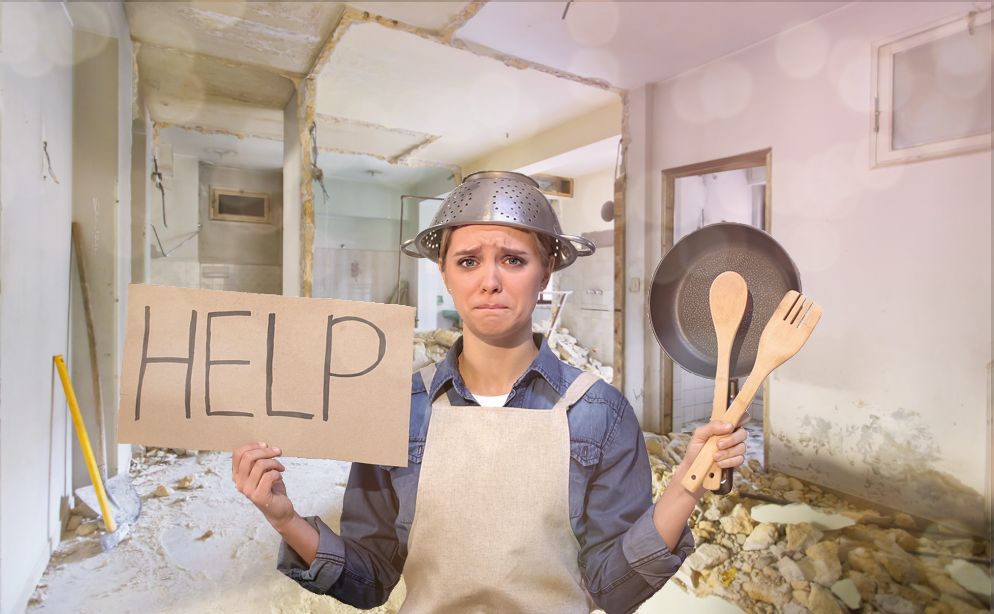Your basket is currently empty!

Thinking of changing, renovating or rejuvenating your kitchen? Read our survival guide below.
Whether your kitchen is old, broken or you just feel like a change, updating your kitchen is for most of us, a major undertaking. Whether you are just planning to change the doors or a brand-new kitchen renovation, the work can be disruptive, time consuming, costly and stressful. Follow our guide below to help ensure you survive the upheaval with a smile.
- Step 1: Budget.
- Step 2. Thinking about your new kitchen.
- Step 3. Time to seek advice.
- Step 4. Take your time.
- Step 5. Single or multiple Contractors.
- Step 6. Choose your team and finalise the budget.
- Step 7. Start Day.
- Step 8. Are you happy?.
- BWT products that can help
The kitchen is probably one room most of us can’t do without for very long, to ease the burden work with your contractor, to ensure items like fridges and cookers are disconnected for the least amount of time possible.
Planning and communication is vital to ensure you and your family can continue to cook, eat, store food and even wash clothes whilst the work is taking place. Whether you are doing the work yourself, liaising with one contractor or many, making sure everyone is on the same page is very important. Our top tips:
- Be realistic with what the project will cost and how long it will take.
- Agree on terms of reference early on, your idea of finished may be very different to someone else’s.
- Agreeing on the scope of work at the outset can save valuable time and disagreements later on. It can be expensive to change your mind once the job is under way.
Step 1: Budget
Setting a realistic budget from the start is a perfect way of avoiding disappointment later on when your vision has to tempered with the reality of what you can afford. Set aside a sensible amount to the following areas of your project: any building work, kitchen units, appliances, taps, tiling, floor coverings, and labour plus if you live in a hard water area, a water softener.
Maybe consider a separate Project Manager as it might seem like a big expense but could be money well spent if your project is large or complex. You may also choose to manage the job yourself or appoint a main contractor.
Create a list of what is important to you, divide it into three columns ‘Essential’. ‘Must Have’ and ‘Nice to Have’ is a pretty good way to start controlling your budget thinking and don’t forget to allow for a contingency typically between 5 and 10% is a good guide.
Step 2. Thinking about your new kitchen?
With one eye on the budget, it is time to look at how you want to use your new kitchen, and how that may change over time.
The average household lives with the same kitchen for over ten years and lot can happen in that time. Tastes change, children grow up, some leave home, some return home. How you use your space is likely to change too.
Understanding how you will use your kitchen will help you polarise your thoughts on what is important to you. Recent years have seen a trend towards open plan living and the kitchen becoming the hub of the home. Will you eat in the kitchen as a family? Do you need a space for the kids to play safely away from your cooking area? Does your new space need to double up as a laundry room?
Answering these types of questions will help you to choose your layout, finishes, floor coverings and accessories. If you live in a hard water area those shiny surfaces and ceramic tiles will need to be protected from limescale. Now could be the perfect time to integrate a water softener into your design. Finally remember to allow flexibility within your design, you can never have to many plug sockets!
Step 3. Time to seek advice.
A quick measure up is a good place to start and remember you don’t have to change your existing layout if it works for you.
With your ideas fresh in your mind a trip to the local kitchen renovation showroom is a perfect way to start the ball rolling and to refine some of your ideas. Take along a floor plan and a note of the location of doors, windows, radiators and even light switches.
The designer at your local showroom will be able to bring your plan to life. A good designer will help you maximise your space and to spot any likely problem areas. A local designer will also be able to advise you about local water conditions and suggest products to improve your drinking water and if you live in a hard water area, products to protect your new kitchen like a water softener.
A showroom can also be the perfect place to pick up ideas but be careful items have a habit of looking smaller in a large showroom. Choosing to work with a designer and their advanced software can help you plan the perfect kitchen renovation the software can even make allowances for the manufacturing and installation tolerances which isn’t always easy to do at home with a pen and paper.
Step 4. Take your time.
Look at your ideas, look at any plans the designer may have drawn for you and look at the choices of kitchen units, appliances and even décor. Our top tip: Time for a cup of tea!
Consider the practicalities of your new kitchen, does it work for you. Can you see your guests when you are preparing a meal? Is there somewhere for the children to have breakfast and where will you dry the dog after a walk in the rain. Is there somewhere to store your sweeping brush and a cupboard to store those things that need to be kept away from children and pets?
Do you need a drinking water system, is now the right time to invest in a boiling water tap? Have you thought about under floor heating or a water softener to help protect your new investment?
Continue your research on the internet seek out blogs, magazine articles and reviews. Involve the family and trusted friends, if you have a contractor lined up talk to them as well before finalising your plan and then review again.
Step 5. Single or multiple contractors?
Many specialist kitchen showrooms or local plumbers and even builders will offer a turnkey solution from start to the final decoration. Others will prefer to focus on just parts of your project and may even want you to buy some of the products yourself (sometimes a good way to save money).
Your list of trades may include: a plumber, an electrician, a kitchen fitter, a tiler, a decorator and maybe a builder. Or you may decide to do some or all of the job yourself.
If you are using multiple contractors then someone will need to manage the project and ensure the work is done in the right order and on time. It is vital to agree a schedule of work for each person involved including a written understanding of any agreed terms of reference e.g. ‘painted’ but what colour and what finish? Single contractor, multiple trades or Project Manager the same principal applies, you must all agree what the job is and ‘looks like’.
Step 6. Choose your team and finalise the budget.
Choose your partners wisely ask for references and always get more than one quotation. Confirm payment terms and check delivery and lead times with your suppliers before booking your tradespeople. If you have chosen a Project Manager then he or she will take on a lot of this responsibility or work closely with you, if you have made it a condition of their role. If you are going it alone then please read the next section carefully.
When choosing a contractor consider who will do the work, are they a sole trader, how many staff do they employ. This is vital to ensure your project runs smoothly sole traders may offer great value for money but if your plumber is taken ill who will cover for them? Local directories and the internet are a valuable resource for finding local trade’s people, many even contain reviews from recent customers. Your local kitchen showroom may also offer their own installation service or be able to recommend someone they trust.
When agreeing a price take the opportunity to finalise your understanding of the job you are asking them to do, agree on the products you have chosen, the timescales the level of finish you are expecting and payment terms. Ask them to confirm the things you have agreed to, in writing. Finally ask to see their public liability insurance for your own peace of mind.
With all your quotes in, it’s time to grab your calculator and workout the final price. If you have been using your check list and jotting down prices as you have gone along, the final figure won’t come as a surprise. Now is also the perfect time to double check all of your lists to ensure nothing has slipped through the net – things like tile cement and grouting, waste traps for your sinks, dishwashers and don’t forget bulbs for the lights or that kitchen blind!
If the total is more than your budget then it’s time to review and to see where savings can be made or where you wish to tap into that vital contingency. It’s hard but don’t let your heart rule your head if the extra cost is likely to cause problems later on. Whilst ‘nice to have’s’ are just that, it can be false economy if it means leaving out a water softener that is vital for protecting sinks, taps, glass and ceramics. Choosing a simpler tap is a better solution than having no tap at all.
If you are happy then it’s time to organise your tradespeople and deliveries.
Step 7. Start Day.
With a confirmed start date, it’s time to prepare yourself and the family for what’s to come next. Clear the kitchen a couple of days before, allow plenty of time as it will probably take longer than you think. Then clear a space to store any items that may arrive before they are needed. Remember it’s not unusual for goods to arrive early or for the job to run a day behind schedule.
Check deliveries for the obvious damage like crushed or broken boxes and make your delivery driver aware before they leave. Photograph the damaged areas and carry out a detailed inspection as soon as possible.
If you have to stay on site during the work, set up a temporary food preparation area. For many people this will involve just a microwave and an electric kettle. Avoid using plug in fryer in all but the safest of locations. Check you have somewhere to store food and moving the fridge and freezer into the garage is also a good idea if you have one. Hopefully this mini kitchen will only be needed for a few days, most professional fitters will ensure that you are without a cooker for the least amount of time possible. Don’t forget to grab some plates and the knives and forks. Finally reach for your favourite take away menu – you are likely to need it!
To keep the family onside let everyone know when the water will be switched off during the day. Talk to your contractors or project manager to ensure your water and electricity is switched back on before they leave at the end of the day. The work can be very dusty so please ensure everyone knows to keep internal doors firmly shut to minimise the dust around your home.
Step 8. Are you happy?
Check the standard of work daily and that things like the layout are what you asked for. It is important to raise issues as soon as they arise, this will help minimise any rework necessary. Take the time to check the job thoroughly before signing the job off and making any final payments. It is important to check for the obvious, like does the oven work, and have any manuals been left in a safe place for you? Holding back a final payment isn’t unreasonable if you are not satisfied. Finally have a really good clean and move all of your personal belongings back into your new kitchen. Register your guarantees and if you have chosen a Luxury Water softener, request your free commissioning.
Pin your takeaway menu’s back on your notice board and if you have taken the opportunity to protect your new kitchen with a water softener, like a lot of modern hotels do, then rest assured it will stay looking like new for longer and be easier to clean, making it perfect for you, your family and your home.
By Ian Fraser our Marketing Manager
BWT products that can help
If you are suffering from hard water, investing in Luxury Water can make a real difference to your home and lifestyle. The BWT Water Softener and BWT drinking water systems are the small investments that make your kitchen renovation last longer.










